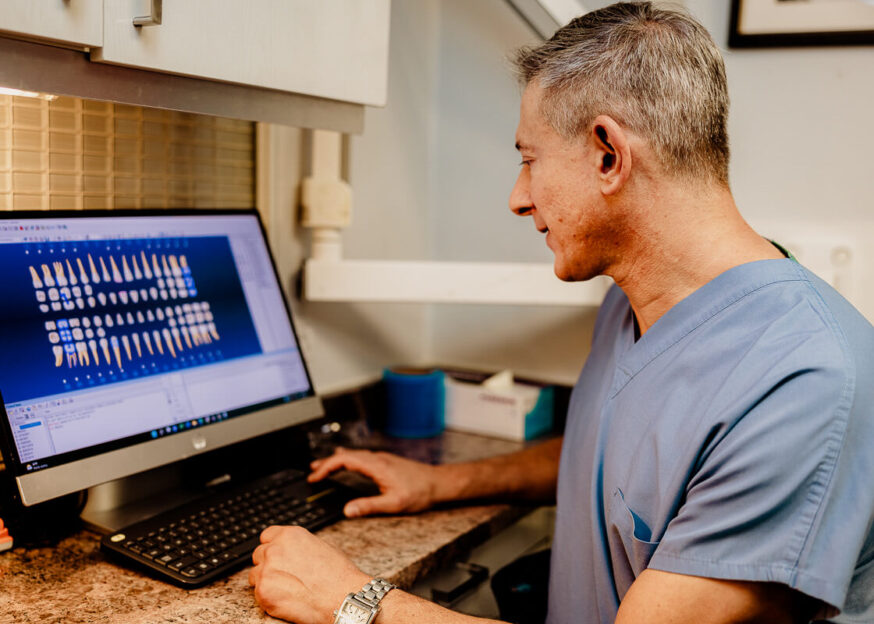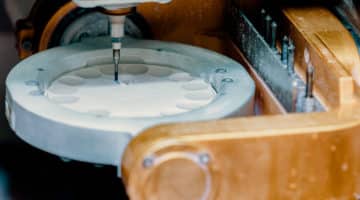Originally published in 2022, updated for advancements in technology in 2023.
As more people are drawn to the need to have and maintain good oral health, digital dental innovations available to both dentists and patients are also on the rise to bridge gaps and lead the population toward better oral health.
Treatment planning in dentistry with technology and the right modern tools and techniques has transformed the healthcare industry and provided patients with personalized and comprehensive oral care. The rise of new dental technology and software has rapidly transformed the field of dentistry, making it easier than ever—in terms of workflow and administration—to examine, diagnose, and treat patients, no matter their specific oral health concerns.
But what does the dental treatment plan of the digital era look like? Here’s what you need to know about the modern dental treatment plan, including the essential components and strategies involved in creating a digital dental treatment plan that maximizes efficiency, precision, flexibility, and patient satisfaction. The Three Types of Dental Patients
While each patient is unique, broadly speaking, dental clinics will regularly see and treat one of three types of patients. The type of patient will often dictate the specifics of what their treatment plan looks like.
What is a dental treatment plan?
A dental treatment plan is essentially a comprehensive roadmap for a client’s dental health. It outlines the recommended treatment for a patient’s teeth, dental procedures, and approaches to address their oral health needs, including how you plan to implement it and the desired treatment outcome.
Usually, dentists or dental specialists, in collaboration with the patient, develop a strategic document accounting for a patient’s oral health conditions, concerns, and goals, providing structured measures and protocols to achieve optimal dental health. You’ll need to lay out your plan in writing to make it available to others and store it for important medical records.
A typical dental plan covers diagnosis, treatment recommendations, treatment plan based on the level of priority where multiple treatments are needed, urgency, importance, and cost estimates. It also includes the timeline for every proposed procedure, a step-by-step sequence of treatments, and their anticipated durations. You can also highlight alternative options of treatment plans, pointing out the benefits and risks associated with each choice.
In a nutshell, a dental treatment plan serves as a communication tool that fosters transparency, assistance by the dentist, collaboration, and informed decision-making between the dentist and the patient. It is a guide that helps dentists deliver personalized care and helps patients understand the recommended treatments, benefits, and expected outcomes.
What are the phases of a dental treatment plan?
Ideally, dentists use a systematic and patient-centered approach to create the phases of a dental treatment plan for their patients. The phases of a dental treatment plan may vary, depending on the patient’s needs and treatment goals. It consists of several phases, outlining the sequential steps in achieving the patient’s desired oral health outcomes.
Here are the general phases commonly found in a dental treatment plan:
Urgent phase
This is where the dentist addresses the patient’s immediate complaint or urgent oral health needs in this phase. This can range from patient-reported pain to dental trauma, soft tissue pathology, aesthetic concerns, and other oral structures. You should carefully consider the patient’s symptoms and concerns to help formulate a diagnosis and plan for care. This involves stabilization, reviewing the patient’s medical and dental history, taking X-rays, and conducting any necessary diagnostic tests and treatment of the problem.
Control phase
The aim is to reduce oral disease and stabilize your patient’s dental health, eliminating active diseases such as caries and inflammation. This is also where you address conditions preventing maintenance, eliminate potential disease causes, and begin preventive dentistry activities, such as extractions, endodontics, periodontal debridement, scaling, and occlusal adjustment as needed. The goals of this phase are to remove etiologic factors and stabilize your patient’s dental health.
Re-evaluation phase
This is the third phase that allows the dentist to pause and review. The intent is to allow time for healing, evaluate treatments, and reinforce messages of dental disease prevention. It also allows you to check in with your patients to see how they are managing and if they require any tailoring to any at-home preventive regimes. It is also known as the holding phase, the time between the control and definitive phases that allow for the resolution of inflammation and time for healing.
Definitive phase
After the dentist reassesses the initial treatment and determines the need for further care, the patient enters the corrective or definitive phase of treatment. The dentist can reassess their patient’s needs and determine if they require further care. This may involve the referral to specialized dental professionals in disciplines such as endodontics, periodontics, orthodontics, oral surgery, special needs, prosthodontics, or pediatrics. It can also include other health professionals, such as physiotherapists, speech pathologists, dietitians, medical professionals, psychologists, and others.
Maintenance phase
This is the final care phase, as it focuses on supportive therapy to maintain the patient’s oral health, which includes establishing an appropriate recall period for the patient’s next dental checkup or review. Dentists can reinforce oral health prevention during these future visits and re-motivate patients to maintain healthy habits. Also, allows the opportunity to reinforce home care.
The three types of dental patients
While each patient is unique, broadly speaking, dental clinics will regularly see and treat one of three types of patients. The type of patient will often dictate the specifics of their treatment plan looks like.
The Problem-Oriented (reactive) Patient
A surprisingly large percentage of dental patients fall into the problem-oriented category. These are the patients that do not see the dentist until they’re dealing with an acute oral issue, such as:
- Traumatic injuries – Such as an avulsed tooth, fractured jaw, occlusal trauma, or displaced tooth.
- Pain associated with individual teeth – Such as a fractured tooth or restoration, cracked tooth, post-tooth extraction pain, pain after restoration, or endodontic therapy.
- Periodontal and soft tissue pain – Such as acute periodontitis, pain after periodontal therapy, periodontal lesion, or acute gingivitis.
For patients in this state, all they want is for the pain to go away. Their tooth issue may have kept them up all night. Or, it could have been a growing concern as the pain increased over time. No matter, they require immediate relief and are dependent on their dentist to provide that urgent dental care.
In many cases, the “must-fix-it” patient may only see the dentist when it’s absolutely necessary.
Regardless of the level of pain, digital dental treatment for this type of patient focuses on alleviating the discomfort as quickly as possible. As a result, most of these issues will typically involve same-day treatment, especially for traumatic injuries.
Whether it’s a broken tooth, pulp necrosis, or an abscessed tooth, digital technologies can both accelerate the treatment lifecycle while making the patient less uncomfortable throughout.
But more on that later.
The Proactive Patient
The second type of patient either doesn’t (to their knowledge) have a pending oral health issue or has an issue that the dentist seeks to address, but doesn’t require immediate attention.
The proactive patient keeps their appointments, practices good oral hygiene, and completes their treatments. For this type of patient, digital dentistry improves the treatment process, minimizing the total number of necessary visits and the time they spend in the chair.
The Discretionary Patient
The final type of patient typically doesn’t have a significant oral health problem, but rather, they want to improve the aesthetics of their smile, whether that’s via dentures, veneers, or tooth whitening.
Digital dentistry has done wonders to speed up these processes while reducing the total sticker price of the procedures. And when that happens, when dental treatments are more affordable, less painful, and easier to perform, dental practices see a greater case acceptance as a larger share of their proactive patients become willing to also slide into the discretionary patient category.
How digital dentistry tools impact dental treatment planning
Digital dentistry has transformed treatment planning, enabling dentists to provide personalized, efficient, and predictable dental care.
A standard digital treatment plan consists of several components created and managed using digital tools and technologies that promote diagnostics, precision, efficiency, and patient satisfaction, and predictable dental care. It facilitates virtual treatment simulations, improves communication, and streamlines the workflow, benefiting dental professionals and patients.
Firstly, the tools to enable ideal digital dental treatment plans:
The intraoral scanner
Intraoral scanners represent the forefront of the digital dental revolution and the first stage of the dental treatment process. These digital devices have completely changed the traditional process for a typical dental workflow like a tooth replacement, zirconia crown, or denture fabrication.
Equipped with an intraoral scanner, dentists and dental hygienists can rapidly scan a patient’s mouth. The device automatically registers the size and shape of each tooth and then uses that data to form a perfect 360° image of the patient’s intraoral cavity.
Intraoral scanners make it possible to capture an ideal dental impression in a fraction of the time—and without all of the unpleasantness associated with the analog process. This creates several benefits, including:
- More accurate impressions
- Less money spent on one-off supplies
- Improved patient experience
- Less patient chair time
- Improved case acceptance since patients can visualize the dental procedure
With technologies such as Dandy’s intraoral scanner, what used to take several weeks and multiple appointments can now be done in the space of two appointments—talk about how to improve the patient experience.
CAD/CAM technology
The second stage of the digital dental treatment procedure involves computer-aided design and computer-aided manufacturing (CAD/CAM) technology. This plays a key role in the digital dental lab process, making it possible for dentists to fabricate complex and accurate restorations quickly and efficiently.
Once the data from the intraoral scanner enters the system, the CAD/CAM technology uses the 3D image to design a final restoration. The lab team receives the digital impression instantly and then makes the necessary adjustments to ensure proper spacing and alignment.
3D printing technology
From there, a milling machine can shape the restoration out of a single ceramic block. The restoration will then be digitally color-matched and stained or glazed for a natural final finish.
In the past, custom dental work relied heavily on manual-based, trial-and-error methodologies. But 3D digital printing technology has automated the customization process, making it more efficient and producing a higher quality end-product—all at a lower cost.
Ways in which digital dentistry fosters ideal dental treatment planning
There’s an adage: Nobody needs a hammer, what they really need is a nail to be driven into a wall so they can hang a painting. While the tools can speak for themselves it helps to see outcomes.
Enhanced communication
Digital dentistry facilitates improved communication between dentists, dental laboratories, and patients. It facilitates the easy sharing of digital files, allowing for seamless collaboration and exchange of information. Dentists can communicate treatment plans visually, using virtual models and simulations, which enhances patient understanding and enables them to make informed decisions.
Efficient workflow
Digital dentistry optimizes the dental treatment workflow by reducing the time required for various procedures. For instance, digital impressions are faster to capture than traditional impressions. In addition, integrating digital technologies eliminates the need for physical models and reduces chairside adjustments, resulting in fewer patient visits and improved efficiency.
Improved diagnostics
Digital imaging techniques enable dentists to accurately diagnose and assess dental conditions, including hidden structures, bone quality, and tooth alignment. Enhanced diagnostics lead to more precise treatment planning. Techniques such as cone-beam computed tomography (CBCT) and intraoral scanners offer detailed 3D images of the oral cavity.
Predictable outcomes
Dentists can achieve more predictable treatment outcomes by utilizing digital tools for treatment planning. The ability to visualize and simulate treatment options, coupled with accurate diagnostics and precise restorations, reduces the margin of error. This leads to improved treatment success rates and enhanced patient satisfaction.
Dandy: Your partner in ideal digital dental treatment
No matter the patient or their specific oral health issue, these digital advancements in dentistry are rapidly changing how dental clinics treat their patients. With digital dentistry, dental professionals don’t have to send patients to specialists or waste precious chair time on time-consuming manual activities, such as analog impressions.
That’s where Dandy makes the difference. With our intraoral scanner and CAD/CAM two-appointment dental process, we can streamline all of your dental office’s typical workflows. What used to take months can now be done in a matter of days. When you’re thinking about how to attract patients to your dental practice, digital dental treatment is the solution clinics need to drive patient satisfaction, increase case acceptance, and improve clinical outcomes.
Dandy provides our doctors’ treatment plans if they use us for the following:
Treatment plans can be found in the Dandy Portal and can be shared with customers. Generally, they include the cost and duration of treatment (aligners specific) and showcase any order add-ons from the doctor. Implant treatment plans are all done by experienced CDTs with the final restoration in mind.
If you’re ready to streamline your dental treatment process, contact us today to get started.
Sources:
Elsevier. Diagnosis and Treatment Planning in Dentistry. https://www.us.elsevierhealth.com/diagnosis-and-treatment-planning-in-dentistry-9780323809757.html
BMC Oral Health. Intraoral Scanners In Dentistry: a Review of the Current Literature. https://www.ncbi.nlm.nih.gov/pmc/articles/PMC5727697/



